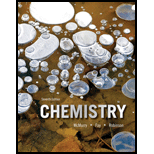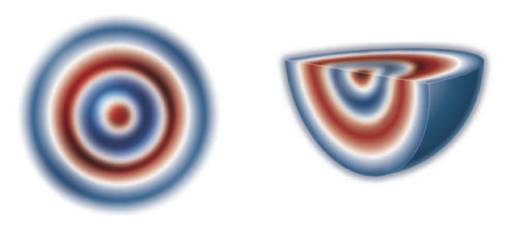
Chemistry (7th Edition)
7th Edition
ISBN: 9780321943170
Author: John E. McMurry, Robert C. Fay, Jill Kirsten Robinson
Publisher: PEARSON
expand_more
expand_more
format_list_bulleted
Textbook Question
Chapter 5, Problem 5.13P
Conceptual PRACTICE 5.13 Give a possible combination of n and I quantum numbers for the following orbital.

Expert Solution & Answer
Want to see the full answer?
Check out a sample textbook solution
Chapter 5 Solutions
Chemistry (7th Edition)
Ch. 5 - Prob. 5.1PCh. 5 - Conceptual APPLY 5.2 Two electromagnetic waves are...Ch. 5 - PRACTICE 5.3 The biological effects of a given...Ch. 5 - Prob. 5.4ACh. 5 - Prob. 5.5PCh. 5 - Conceptual APPLY 5.6 Compare the two elements Rb...Ch. 5 - PRACTICE 5.7 The Balmer equation can be extended...Ch. 5 - APPLY 5.8 (a) What is the longest-wavelength line...Ch. 5 - Prob. 5.9PCh. 5 - Prob. 5.10A
Ch. 5 - Prob. 5.11PCh. 5 - APPLY 5.10 Extend Table 5.2 to show allowed...Ch. 5 - Conceptual PRACTICE 5.13 Give a possible...Ch. 5 - Conceptual APPLY 5.14 How many nodal planes...Ch. 5 - Prob. 5.15PCh. 5 - Conceptual APPLY 5.16 Identify the atoms with the...Ch. 5 - Prob. 5.17PCh. 5 - APPLY 5.18 Predict which bond length will be the...Ch. 5 - PROBLEM 5.19 Mercury vapor is contained inside the...Ch. 5 - PROBLEM 5.20 When electricity is used to add...Ch. 5 - Prob. 5.21PCh. 5 - PROBLEM 5.22 Three different wavelengths in the...Ch. 5 - Prob. 5.23PCh. 5 - Two electromagnetic waves are represented below....Ch. 5 - The following diagram shows the energy levels of...Ch. 5 - Identify each of the following orbitals, and give...Ch. 5 - Where on the blank outline of the periodic table...Ch. 5 - One of the elements shown on the following...Ch. 5 - What atom has the following orbital-filling...Ch. 5 - The following orbital-filling diagram represents...Ch. 5 - Prob. 5.31CPCh. 5 - Which has the higher frequency, red light or...Ch. 5 - Prob. 5.33SPCh. 5 - The Hubble Space Telescope detects electromagnetic...Ch. 5 - Prob. 5.35SPCh. 5 - Prob. 5.36SPCh. 5 - Prob. 5.37SPCh. 5 - Prob. 5.38SPCh. 5 - Prob. 5.39SPCh. 5 - Prob. 5.40SPCh. 5 - Prob. 5.41SPCh. 5 - Prob. 5.42SPCh. 5 - Prob. 5.43SPCh. 5 - Prob. 5.44SPCh. 5 - Prob. 5.45SPCh. 5 - Prob. 5.46SPCh. 5 - Prob. 5.47SPCh. 5 - Prob. 5.48SPCh. 5 - Prob. 5.49SPCh. 5 - Prob. 5.50SPCh. 5 - Prob. 5.51SPCh. 5 - Prob. 5.52SPCh. 5 - Prob. 5.53SPCh. 5 - Prob. 5.54SPCh. 5 - Prob. 5.55SPCh. 5 - Spectroscopy is a technique that uses the...Ch. 5 - Prob. 5.57SPCh. 5 - Prob. 5.58SPCh. 5 - Prob. 5.59SPCh. 5 - Prob. 5.60SPCh. 5 - Prob. 5.61SPCh. 5 - Prob. 5.62SPCh. 5 - What velocity would an electron ( mass=9.111031...Ch. 5 - Prob. 5.64SPCh. 5 - Prob. 5.65SPCh. 5 - Prob. 5.66SPCh. 5 - Prob. 5.67SPCh. 5 - Prob. 5.68SPCh. 5 - Prob. 5.69SPCh. 5 - Prob. 5.70SPCh. 5 - Prob. 5.71SPCh. 5 - Prob. 5.72SPCh. 5 - Prob. 5.73SPCh. 5 - Prob. 5.74SPCh. 5 - Prob. 5.75SPCh. 5 - Prob. 5.76SPCh. 5 - Prob. 5.77SPCh. 5 - Prob. 5.78SPCh. 5 - Prob. 5.79SPCh. 5 - Prob. 5.80SPCh. 5 - Prob. 5.81SPCh. 5 - Prob. 5.82SPCh. 5 - Prob. 5.83SPCh. 5 - Prob. 5.84SPCh. 5 - Prob. 5.85SPCh. 5 - Prob. 5.86SPCh. 5 - Prob. 5.87SPCh. 5 - Prob. 5.88SPCh. 5 - Prob. 5.89SPCh. 5 - Prob. 5.90SPCh. 5 - Prob. 5.91SPCh. 5 - Prob. 5.92SPCh. 5 - Prob. 5.93SPCh. 5 - Prob. 5.94SPCh. 5 - Prob. 5.95SPCh. 5 - Prob. 5.96SPCh. 5 - Draw orbital-filling diagrams for atoms with the...Ch. 5 - Prob. 5.98SPCh. 5 - Prob. 5.99SPCh. 5 - Prob. 5.100SPCh. 5 - Prob. 5.101SPCh. 5 - Prob. 5.102SPCh. 5 - Prob. 5.103SPCh. 5 - Prob. 5.104SPCh. 5 - Prob. 5.105SPCh. 5 - Prob. 5.106SPCh. 5 - Prob. 5.107SPCh. 5 - Prob. 5.108SPCh. 5 - Prob. 5.109SPCh. 5 - What is the expected ground-state electron...Ch. 5 - What is the atomic number and expected...Ch. 5 - Prob. 5.112CPCh. 5 - Prob. 5.113CPCh. 5 - Prob. 5.114CPCh. 5 - 5.115 Lines in a certain series of the hydrogen...Ch. 5 - Prob. 5.116CPCh. 5 - Prob. 5.117CPCh. 5 - Prob. 5.118CPCh. 5 - Prob. 5.119CPCh. 5 - Prob. 5.120CPCh. 5 - Prob. 5.121CPCh. 5 - Prob. 5.122CPCh. 5 - Prob. 5.123CPCh. 5 - Prob. 5.124CPCh. 5 - Prob. 5.125CPCh. 5 - Prob. 5.126CPCh. 5 - Prob. 5.127CPCh. 5 - Prob. 5.128CPCh. 5 - Prob. 5.129CPCh. 5 - Prob. 5.130CPCh. 5 - Prob. 5.131CPCh. 5 - Prob. 5.132CPCh. 5 - Prob. 5.133CPCh. 5 - Prob. 5.134CPCh. 5 - Prob. 5.135CPCh. 5 - Prob. 5.136CPCh. 5 - Prob. 5.137CPCh. 5 - Prob. 5.138CPCh. 5 - Prob. 5.139MPCh. 5 - Prob. 5.140MPCh. 5 - Prob. 5.141MP
Knowledge Booster
Learn more about
Need a deep-dive on the concept behind this application? Look no further. Learn more about this topic, chemistry and related others by exploring similar questions and additional content below.Similar questions
- 6.32 What are the mathematical origins of quantum numbers?arrow_forwardWhich of the following sets of quantum numbers correctly represents a 4p orbital? (a) n = 4, = 0, m = 1 (b) n = 4, = 1, m = 0 (c) n = 4, = 2, m = 1 (d) n = 4, = 1, m =2arrow_forwardGive the possible values of a. the principal quantum number, b. the angular momentum quantum number, c. the magnetic quantum number, and d. the spin quantum number.arrow_forward
- What experimental evidence supports the quantum theory of light? Explain the wave-particle duality of all matter .. For what size particles must one consider both the wave and the particle properties?arrow_forwardUse the mathematical expression for the 2pz wave function of a one-electron atom (see Table 5.2) to show that the probability of finding an electron in that orbital anywhere in the x-y plane is 0. What are the nodal planes for a dxz orbital and for a dx2y2 orbital?arrow_forward6.106 When Bohr devised his model for the atom, was he using deductive or inductive reasoning? Explain your answer.arrow_forward
- • list the number of orbitals of each type (1s, 3p, etc) in an atom.arrow_forwardConstruct an energy level diagram showing all orbitals for the hydrogen atom up to n=5, labeling each orbital with its appropriate quantum numbers. How many different orbitals are in each shell?arrow_forwardDefend and criticize Bohrs model. Why was it reasonable that such a model was proposed, and what evidence was there that it "works"? Why do we no longer "believe" in it?arrow_forward
- Explain the main features of Bohrs theory. Do these features solve the difficulty alluded to in Question 7.8?arrow_forwardHow many electrons in an atom can have the following quantum designation? (a) 1s (b) 4d, m l =0(c) n=5,l=2arrow_forwardUse the aufbau procedure to obtain the electron configuration and orbital diagram for atoms of the following elements. (a) Be (b) B (c) Ne (d) Rbarrow_forward
arrow_back_ios
SEE MORE QUESTIONS
arrow_forward_ios
Recommended textbooks for you
 Principles of Modern ChemistryChemistryISBN:9781305079113Author:David W. Oxtoby, H. Pat Gillis, Laurie J. ButlerPublisher:Cengage Learning
Principles of Modern ChemistryChemistryISBN:9781305079113Author:David W. Oxtoby, H. Pat Gillis, Laurie J. ButlerPublisher:Cengage Learning Physical ChemistryChemistryISBN:9781133958437Author:Ball, David W. (david Warren), BAER, TomasPublisher:Wadsworth Cengage Learning,
Physical ChemistryChemistryISBN:9781133958437Author:Ball, David W. (david Warren), BAER, TomasPublisher:Wadsworth Cengage Learning, Chemistry for Engineering StudentsChemistryISBN:9781337398909Author:Lawrence S. Brown, Tom HolmePublisher:Cengage Learning
Chemistry for Engineering StudentsChemistryISBN:9781337398909Author:Lawrence S. Brown, Tom HolmePublisher:Cengage Learning Chemistry & Chemical ReactivityChemistryISBN:9781133949640Author:John C. Kotz, Paul M. Treichel, John Townsend, David TreichelPublisher:Cengage Learning
Chemistry & Chemical ReactivityChemistryISBN:9781133949640Author:John C. Kotz, Paul M. Treichel, John Townsend, David TreichelPublisher:Cengage Learning Chemistry & Chemical ReactivityChemistryISBN:9781337399074Author:John C. Kotz, Paul M. Treichel, John Townsend, David TreichelPublisher:Cengage Learning
Chemistry & Chemical ReactivityChemistryISBN:9781337399074Author:John C. Kotz, Paul M. Treichel, John Townsend, David TreichelPublisher:Cengage Learning Chemistry by OpenStax (2015-05-04)ChemistryISBN:9781938168390Author:Klaus Theopold, Richard H Langley, Paul Flowers, William R. Robinson, Mark BlaserPublisher:OpenStax
Chemistry by OpenStax (2015-05-04)ChemistryISBN:9781938168390Author:Klaus Theopold, Richard H Langley, Paul Flowers, William R. Robinson, Mark BlaserPublisher:OpenStax

Principles of Modern Chemistry
Chemistry
ISBN:9781305079113
Author:David W. Oxtoby, H. Pat Gillis, Laurie J. Butler
Publisher:Cengage Learning

Physical Chemistry
Chemistry
ISBN:9781133958437
Author:Ball, David W. (david Warren), BAER, Tomas
Publisher:Wadsworth Cengage Learning,

Chemistry for Engineering Students
Chemistry
ISBN:9781337398909
Author:Lawrence S. Brown, Tom Holme
Publisher:Cengage Learning

Chemistry & Chemical Reactivity
Chemistry
ISBN:9781133949640
Author:John C. Kotz, Paul M. Treichel, John Townsend, David Treichel
Publisher:Cengage Learning

Chemistry & Chemical Reactivity
Chemistry
ISBN:9781337399074
Author:John C. Kotz, Paul M. Treichel, John Townsend, David Treichel
Publisher:Cengage Learning

Chemistry by OpenStax (2015-05-04)
Chemistry
ISBN:9781938168390
Author:Klaus Theopold, Richard H Langley, Paul Flowers, William R. Robinson, Mark Blaser
Publisher:OpenStax
Quantum Numbers, Atomic Orbitals, and Electron Configurations; Author: Professor Dave Explains;https://www.youtube.com/watch?v=Aoi4j8es4gQ;License: Standard YouTube License, CC-BY
QUANTUM MECHANICAL MODEL/Atomic Structure-21E; Author: H to O Chemistry;https://www.youtube.com/watch?v=mYHNUy5hPQE;License: Standard YouTube License, CC-BY